UPSC Exam > UPSC Notes > Agriculture Optional for UPSC > Propagation and Dissemination of Weed Seeds
Propagation and Dissemination of Weed Seeds | Agriculture Optional for UPSC PDF Download
| Table of contents |

|
| Propagation |

|
| Reproduction by seed |

|
| Vegetative Reproduction |

|
| Dissemination/ Dispersal |

|
Propagation
- Propagation is defined as the process of increasing the number of plants within the same species.
- This process also aims to preserve and perpetuate the desirable characteristics of the plants.
- Plant propagation is categorized into two main types:
- Sexual propagation, which involves the use of seeds.
- Asexual propagation, which includes methods that do not involve seeds, such as cuttings, grafting, and division.
Reproduction by seed
- Reproduction through seeds is known as sexual reproduction.
- This process necessitates pollination and the fertilization of an egg, leading to the creation of a seed capable of growing into a new plant.
- The amount of seed production significantly varies both among and within weed species, influenced by several factors:
- Environmental changes from year to year.
- Competition with surrounding plants.
- Genetic diversity within species.
- For instance:
- Canada thistle has been recorded to produce as low as 680 seeds per individual plant.
- Curly dock, on the other hand, can produce more than 30,000 seeds per plant.
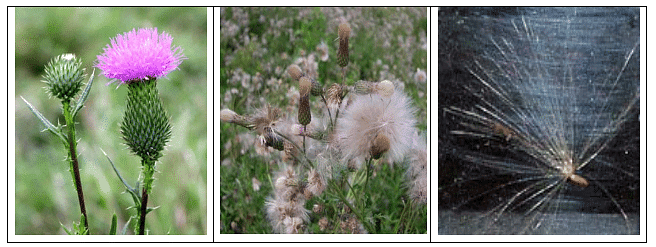
Vegetative Reproduction
- Vegetative (asexual) reproduction involves a new plant growing from a vegetative part, such as a stem, root, or leaf.
- Common in perennial weeds, modifications include:
- Underground stems (rhizomes)
- Above-ground stems (stolons)
- Bulbs
- Corms
- Tubers
- Although vegetative parts generally don't last as long in soil compared to seeds, very small pieces can still sprout new plants.
- For instance, a 1/4-inch root section of Canada thistle can grow into a new plant.
- Vegetative reproduction can rival seed production in its prolific nature.
- Yellow nut-sedge (Cyperus esculentus) is capable of producing over 1,900 new plants and more than 6,800 tubers within a single year.
- Specifically for Cyperus esculentus, tubers are a significant means of vegetative reproduction.
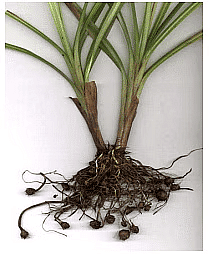
Dissemination/ Dispersal
- A plant seed represents a unique genetic individual in a state of diapause, awaiting favorable conditions to grow into an adult plant capable of producing seeds.
- The life cycle of a seed includes:
- Germination in a safe environment.
- Establishment as a young seedling.
- Development into a juvenile plant.
- Maturation into a sexually mature adult to propagate genetic material to the next generation.
- Seed dispersal away from the parent plant enhances survival chances due to:
- Reduced competition with the parent, as related organisms have similar ecological needs.
- The necessity for seeds to find a suitable habitat for growth.
- Seeds are inherently immobile but have evolved to be excellent travelers through various dispersal mechanisms.
- Certain seeds possess anatomical features enabling buoyancy for wind dispersal over long distances.
- The absence of dispersal mechanisms would limit weed spread across countries.
- Effective seed and fruit dispersal relies on:
- A successful dispersing agent.
- The seed's adaptation to new environments, crucial for weed proliferation and making eradication challenging.
There are two ways of looking at weed seed dispersal
- Expansion of an invading weed species involves:
- Increase in range.
- Growth in population size within a new area.
- Maintenance of an established weed species involves:
- Stabilization and self-perpetuation within an existing area.
- Dissemination of seeds encompasses two distinct phases:
- Dispersal: The departure of the seed from the mother plant.
- Post-dispersal events: Movements occurring after initial dispersal.
- Seed dispersal occurs across four dimensions:
- Length (across the land/habitat/soil surface).
- Width (across the land/habitat/soil surface).
- Height (involving soil depth or aerial dispersal).
- Time (timing varies from immediate post-ripening shatter to requiring an external force like harvesting for release).
- Common agents facilitating weed seed dispersal include:
- Wind
- Water
- Animals
- Humans
- Machinery
(a) Wind
- Many seeds have adaptations for wind travel, including:
- Cottony coverings.
- Parachute-like structures.
- Examples of wind-dispersed seeds:
- Common milkweed (Asclepias syriaca).
- Common dandelion.
- Canada thistle.
- Perennial sowthistle (Sonchus arvensis).
Wind-dispersed seeds and fruits often have specialized organs for floatation:
- Pappus: A parachute-like modification of the calyx into hairs.
- Example: Asteraceae family weeds, such as Tridax procumbens.
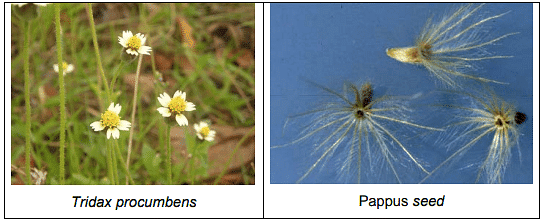
- Comose: Seeds partially or fully covered with hairs.
- Example: Calotropis species.

- Feathery, persistent styles: Styles that are persistent and feathery.
- Example: Anemone species.

- Balloon: Modified papery calyx that loosely encloses fruits, trapping air.
- Example: Physalis minima.
- Wings: Appendages acting as wings.
- Example: Acer macrophyllum.
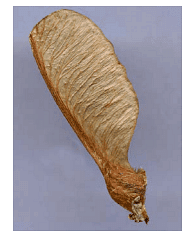
- Factors influencing wind dispersal include:
- Seed weight.
- Seed shape.
- Presence of structures such as wings or pappus.
- Height from which the seed is released.
- Wind speed and turbulence.
(b) Water
- Aquatic weeds predominantly disperse through water, utilizing:
- Whole plants.
- Plant fragments.
- Seeds, carried by water currents.
- Terrestrial weed seeds can also spread via:
- Irrigation water.
- Drainage systems.
- Weed seeds often enter irrigation systems and ponds through surface water runoff, leading to dispersion across different fields.
- The primary source of weed seed in irrigation water is:
- Weeds growing along ditch banks of irrigation canals and ponds.
- Weed seeds can remain viable in water for years, forming a "floating seedbank" that facilitates dispersal over large distances.
- An example of long-term viability in water is:
- Field bindweed seeds maintaining over 50% viability after more than 4 years submerged.
- Some seeds possess unique adaptations for water travel, such as:
- The seedpod of curly dock, which has pontoons for buoyancy.
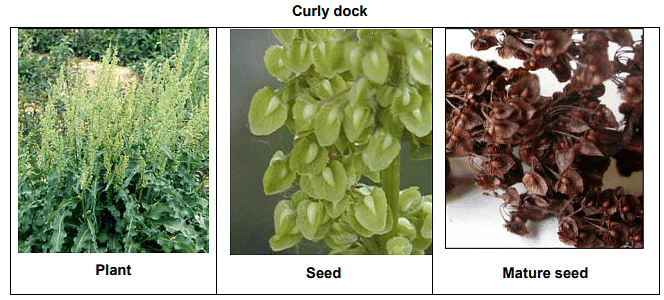
- The seedpod of curly dock, which has pontoons for buoyancy.
(c) Animals
- Weed species disperse seeds through various appendages that allow attachment to animals or clothing, enabling long-distance dispersal. These appendages include:
- Barbs, hooks, spines, and rasps.
- Farm animals are carriers of weed seeds and fruits, transporting them on their:
- Skin.
- Hair.
- Hooves.
- Specific examples of weed seeds with specialized appendages for animal dispersal:
- Hooks: Xanthium strumarium.
- Stiff hairs: Cenchrus spp.
- Sharp spines: Tribulus terrestris.
- Scarious bracts: Achyranthus aspera.
- Ants and donkeys are also agents of weed seed dispersal:
- Ants transport a significant number of seeds.
- Donkeys consume and disperse Prosophis julifera pods.
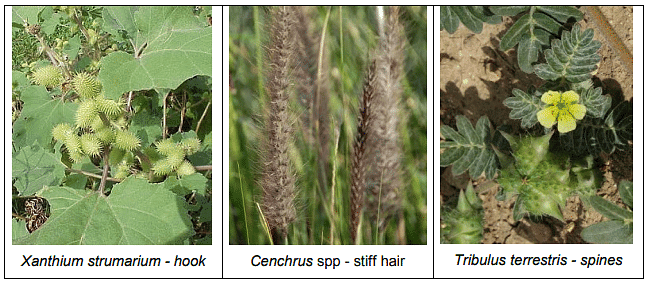
- Weed seeds ingested by animals can pass through their digestive systems and remain viable:
- A small percentage of ingested seeds survive and are excreted in a viable state.
- Viability rates in animal excreta vary (0.2% in chicks, 9.6% in calves, 8.7% in horses, and 6.4% in sheep).
- This form of dispersal, known as endozoochory, includes examples like:
- Lantana seeds dispersed by birds.
- Loranthus seeds sticking to bird beaks.
- Farm animal dung containing viable weed seeds contributes to the "floating seedbank":
- Dung is used as farmyard manure (FYM), providing nutrients and moisture for weed germination.
- Additionally, incorporating mature weeds into compost pits as farm waste serves as a seed source.
(d) Dispersal by Man
- Man unknowingly disperses numerous weed seeds and fruits along with raw agricultural produce.
- Weeds mature at the same time and height as the crop, resembling crop seeds in size and shape.
- Due to their similarity to crop seeds, man unknowingly harvests the weeds along with the crop.
- This unintentional harvesting aids in the dispersal of weed seeds.
- Weeds exhibiting this behavior are referred to as "Satellite weeds."
- Examples of satellite weeds include Avena fatua and Phalaris minor.
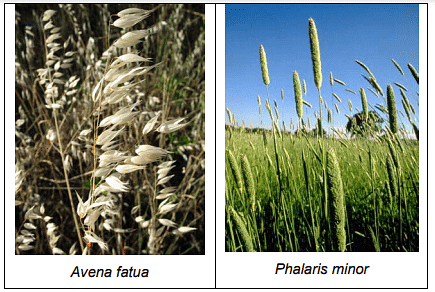
(e) Dispersal by machinery
- Weed seeds are commonly dispersed by tillage and harvesting equipment.
- Seeds can transfer from one field to another via soil sticking to tractor tires.
- Vegetative structures of weeds also travel on tillage and cultivation equipment.
- These vegetative parts are often dropped in other fields, initiating new infestations.
- Disc-type cultivation equipment is less prone to dragging vegetative plant parts compared to shovels or sweeps.
(f) Intercontinental movement of weeds:
- Weeds can be introduced from one continent to another through various means such as crop seeds, feedstock, packing material, and nursery stock.
- Examples of weeds introduced through these means include Parthenium hysterophorus.
- The introduction of weeds via these channels can lead to the spread and establishment of invasive species in new regions.
(g) Crop mimicry dispersal
- Weed seeds have adaptations to mimic crop seeds, with their plant bodies or seeds being similar in size, shape, and morphology to those of the crop.
- For instance, a barnyard grass biotype may resemble rice, making it difficult to distinguish during hand weeding and leading to its unintentional dispersal with rice.
- Similarly, nightshade fruits, often mistaken for "berries," exhibit the same size and shape as dry beans, resulting in their unintentional harvest and dispersal with beans.
(h) As admixtures with crop seed, animal feed, hay and straw.
- Weeds are likely spread more commonly during the seeding of a new crop or through animal feed and bedding compared to other methods.
- Seed labels often indicate a minimal percentage of weed seed, but consider this scenario: if a legume seed contains 0.001 percent dodder seed by weight, there would be eight dodder seeds per 2 kg of legume seed.
- Despite the extremely low percentage of dodder seed by weight, sowing the legume seed in a field can still result in an infested legume field within a single season.
- This is because the small size of the seed, combined with rapid early-season growth, facilitates the establishment of weeds like dodder.
The document Propagation and Dissemination of Weed Seeds | Agriculture Optional for UPSC is a part of the UPSC Course Agriculture Optional for UPSC.
All you need of UPSC at this link: UPSC
|
52 videos|224 docs
|
FAQs on Propagation and Dissemination of Weed Seeds - Agriculture Optional for UPSC
| 1. How do weeds propagate and disperse their seeds? |  |
Ans. Weeds can propagate and disperse their seeds through various means such as wind, water, animals, and human activities. This allows them to spread rapidly and establish new populations in different areas.
| 2. What is the significance of understanding the propagation and dissemination of weed seeds? |  |
Ans. Understanding how weed seeds propagate and disperse is crucial for effective weed management strategies. By knowing how weeds spread, farmers and gardeners can take steps to prevent their proliferation and reduce the impact on crops and native plant species.
| 3. How can vegetative reproduction contribute to the spread of weeds? |  |
Ans. Vegetative reproduction in weeds involves the growth of new plants from stems, roots, or other plant parts. This method allows weeds to rapidly colonize new areas without the need for seeds, making them particularly difficult to control.
| 4. What are the common methods of dissemination used by weeds? |  |
Ans. Weeds can use various methods of dissemination, including seed dispersal by wind, water, animals, or human activities. Some weeds have specialized adaptations for dispersal, such as hooks or spines that attach to passing animals.
| 5. How can farmers and gardeners prevent the propagation and dissemination of weed seeds? |  |
Ans. Farmers and gardeners can prevent the spread of weed seeds by practicing good weed management techniques such as timely removal of weeds, using mulch to prevent seed germination, and avoiding the introduction of new weed seeds through contaminated soil or equipment.
Related Searches




















